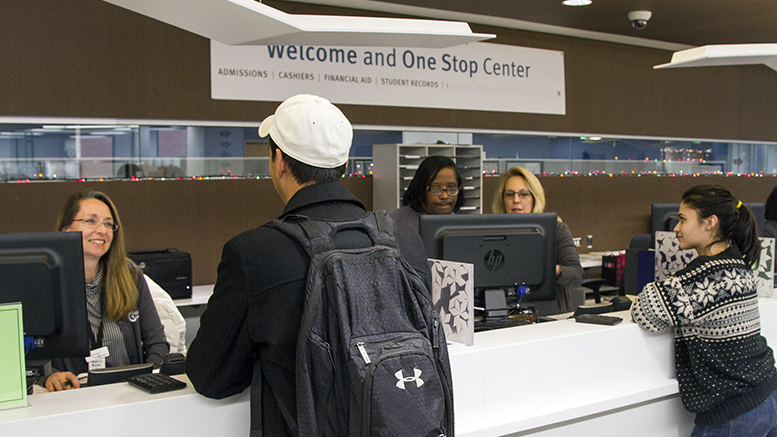Community college students are faced with a variety of complex procedures and decisions, from navigating financial aid applications and lengthy course lists, all the while determining how these immediate choices will serve their long-term educational goals.
This article is an excerpt from the February/March issue of AACC’s Community College Journal.
For many individuals either thinking about community college or already enrolled, these tasks can contribute to a sense that they don’t belong in a higher education setting. Taking note of this plight are community college presidents and administrators, who in the tradition of open access are seeking to provide better customer service to hopeful learners.
Colleges intent on bettering the siloed student support functions lending to high dropout rates — about 70 percent of California community college attendees fail to graduate or transfer, according to the Institute for Higher Education Leadership & Policy at Cal State Sacramento — are offering hands-on assistance that begins during outreach and continues to completion.
The effort involves moving from an advising model focused on provision of impersonal information to one of holistic support, where all learners, no matter their circumstance, are connected to an easy-to-access network of institutional services. This personalized approach is bolstered by the private sector mantra of “the customer is always right,” even if administrators aren’t completely comfortable referring to students as such.
Regardless of how community college students are labeled by leadership, a change in philosophy is needed for institutions to serve the academically unprepared and other underserved populations, say experts.
“When we give poor customer service, it’s usually because our bureaucracy breaks down,” says Terry Murrell, president of Western Iowa Tech Community College (WITCC) and president-elect of the Continuous Quality Improvement Network (CQIN). “The college process was created by four-year private schools. When community colleges came along, we borrowed those ideals, even if we were open enrollment. Most of those processes were more intent on keeping people out than keeping them in, so we need to work on another process.”
Taking a corporate cue
CQIN assists community colleges with best organizational practices, including how to make faculty and staff more customer-minded and put students back at the center of everything a college does.
A people-focused methodology should seem obvious. But fractured front-office support still exists, with registrars, financial-aid offices and academic advisors often spread out among different departments. Also, these services’ operating hours likely aren’t convenient for students who work during the day and attend class at night. Large caseloads for advisors further exacerbate the issue. Data from the 2011 National Survey of Academic Advising recorded a ratio of 296 students to one full-time advisor.
WITCC designed its newly enacted strategic plan directly with the learner in mind. Improving student completion rates, for example, involved faculty thinking of themselves as members of a team rather than individual departments. WITCC’s integrated method “creates a learner environment that promotes access, engagement and success,” according to school marketing materials.

Western Iowa Tech Community College designed its newly enacted strategic plan directly with the learner in mind, says President Terry Murrell. (Photo: WITCC)
“Students may have special issues they bring to the table that get lost among departments,” Murrell says. “To fix that, we have to work together, to be willing to take each other’s calls, and understand that students come to us because they want a better life.”
Community colleges, including WITCC, are taking cues from private businesses in scaling up their customer service. WITCC administrators harness private-sector lessons from Toyota, Kimberly-Clark, Disney, the Ritz-Carlton hotel chain and other established companies.
WITCC administrative staffers hold daily “stand-up” meetings similar to the Ritz-Carlton employee lineups designed to anticipate problems, discuss customer needs, or report activities that represent the company’s overall mission. Put into practice, WITCC staff may keep each other apprised of an upcoming recruitment visit in order to ensure their guest receives the utmost care when on campus.
“The meetings are a time to coordinate,” Murrell says. “If there’s a recruitment visit, nobody on staff is going to be surprised. If a guest comes in through the wrong door, they will be pointed the right way.”
WITCC further models its customer service principles on Disney theme parks, particularly in campus improvements that make its facilities welcoming and accessible. The college’s main campus consists of six interconnected buildings, including a new Learning Achievement Center providing drop-in tutoring and other services. Tutoring is integrated into the space as a means of removing the stigma some learners feel when receiving extra academic assistance.
“It’s a one-stop shop for tutoring and assistance that was previously underutilized by our students,” Murrell says. “Through the Disney philosophy, we found ways to open everything up and make it more accessible. We have seven or eight staff in this open area just walking around and helping students.”
Read the full article online in the new issue of the Community College Journal.

